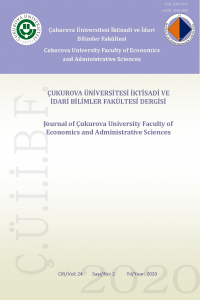Ticaret Performansı Ölçümlerine Çok Boyutlu Bir Yaklaşım: Seçilmiş Ülke ve Sektörlere İlişkin Karşılaştırmalı Analizler
Ticaret performansı, yükselen sanayi ekonomileri (YSE), sektörel analiz, Türkiye
___
- Balassa, B. (1965), Trade Liberalisation and ‘Revealed’ Comparative Advantage. The Manchester School of Economics and Social Studies, 33, 99-123.
- Balassa, B. (1986), Comparative Advantage in Manufactured Goods: A Reappraisal. The Review of Economics and Statistics, 68(2), 315-319.
- Bhattacharyya, R. (2011), Revealed Comparative Advantage and Competitiveness: A Case Study for India in Horticultural Products. International Conference On Applied Economics – ICOAE 2011. http://kastoria.teikoz.gr/icoae2/wordpress/wpcontent/uploads/2011/10/003.pdf
- Cooper, J. (2006), Of BRICs and Brains: Comparing Russia with China, India, and Other Populous Emerging Economies. Eurasian Geography and Economics, 47(3), 255-284.
- Daniels, J. D. (1991), The Elusive Concept of National Competitiveness. Business Horizons, 34(6), 3-6.
- Davies, H. & P. Ellis (2000), Porter’s Competitive Advantage of Nations: Time for the Final Judgement?. Journal of Management Studies, 37(8), 1189-1213.
- EIA-US Energy Information Administration (2015), http://www.eia.gov Eichengreen, R. B. & H. Tong (2007), China and the Exports of Other Asian Countries. Review of World Economics, 143(2), 201-226.
- Hausmann, R. & B. Klinger (2006), Structural Transformation and Patterns of Comparative Advantage in the Product Space. Harvard University, John F. Kennedy School of Government Working Paper Series, RWP06, http:// www.hks.harvard.edu/content/download/69156/1249434/version/1/file/128.pdf
- IMF (2011), Changing Patterns of Global Trade. http://www.imf.org/external/np/pp/eng/2011/061511.pdf
- IBRC (2013), U.S. and Indiana Trade Patterns with the BRICS Countries and Other (Often Overlooked) Emerging Markets.
- http://www.ibrc.indiana.edu/studies/BRICS2013.pdf
- ITC (2014), http://legacy.intracen.org/appli1/TradeCom/Documents/ TradeCompMapTrade%20Performance%20Index-Technical%20Notes-EN.pdf
- ITC (2015), Trade Competitiveness Map. http://legacy.intracen.org.
- İTKİP (2014), Tekstil Sektörü İhracat Performans Değerlendirmesi: 2014 Ocak-Mart, İstanbul, İTKİP Genel Sekreterliği, http://www.itkib.org.tr/.
- Krugman, P. R. (1994), Competitiveness: A Dangerous Obsession. Foreign Affairs, 73(2), 28-44.
- Lall, S. & M. Albaladejo (2004), China’s Competitive Performance: A Threat to East Asian Manufactured Exports? World Development, 32(9), 1441-1466.
- Rodrik, D. (2007), Industrial Development: Some Stylized Facts and Policy Directions. UN-DESA, Industrial Development for the 21st Century: Sustainable Development Perspectives. New York: UN, 7-28.
- Seymen, D. & N. Şimşek (2006), Türkiye ile Çin’in OECD Pazarında Rekabet Gücü Karşılaştırması. İktisat İşletme ve Finans, 21(244), 38-50.
- Smit, A. J. (2010), The Competitive Advantage of Nations: Is Porter’s Diamond Framework a New Theory that Explains the International Competitiveness of Countries? Southern African Business Review, 14(1), 105-130.
- Soyak, A. (2005), Avrupa Birliği Sürecinde Türkiye Sanayi Politikası Üzerine Eleştirel Bir Yaklaşım. TMMOB Ölçü Dergisi, Bilim ve Teknoloji Özel Sayısı, 61-69.
- Togan, S. (2012), The EU-Turkey Customs Union: A Model for Future Euro-Med Integration. MEDPRO Technical Reports, 9.
- http://www.medproforesight.eu/system/files/MEDPRO%20TR%20No%209%20 WP5%20Togan.pdf
- UN (2015), http://unstats.un.org/unsd/cr/registry/regcst.asp?Cl=14
- UN-COMTRADE (2015), http://comtrade.un.org/db/
- UNCTAD (2015), UNCTADStat. http://unctadstat.unctad.org/
- UNIDO (2013), Country Grouping in UNIDO Statistics.
- https://www.unido.org/fileadmin/user_media/Services/PSD/Country_Grouping_in _UNIDO_Statistics_2013.pdf
- Venables, T. & L. Yueh (2006), The China Effect. http://cep.lse.ac.uk/pubs/download/CP208.pdf
- Wood, A. & J. Mayer (2010), Has China De-Industrialised other Developing Countries? QEH Working Paper Series, 175. http://www3.qeh.ox.ac.uk/pdf/qehwp/qehwps175.pdf
- WTO (2014), Connecting to Global Markets. Challenges and Opportunities: Case Studies Presented by WTO Chair-Holders, (Ed. M. Jansen, M. Sadni, J. M. Smeets), Geneva: WTO Publications.
- https://www.wto.org/english/res_e/publications_e/connecting_markets_e.htm Yıldırım, E. & C. Dura (2007), Gümrük Birliği’nin Türkiye Ekonomisi Üzerindeki Etkileri Konusundaki Literatüre Bir Bakış. Erciyes Üniv. İ.İ.B.F. Dergisi, 28, 141- 177.
- ISSN: 1300-3747
- Başlangıç: 1987
- Yayıncı: Çukurova Üniversitesi
Kargo Şirketi Seçimine Yönelik Kriterlerin Belirlenmesinde Türkiye Genelinde Bir Saha Araştırması
Balassa-Samuelson Hipotezinin İçsel Aktarım Mekanizmasının Türkiye Ekonomisi İçin Test Edilmesi
Gelişmekte Olan Ülkelerde Yaygın Eğitimin Yoksulluğu Azaltma Üzerindeki Etkisi
Makro Ekonomik ve Politik İstikrarsızlığın Ekonomik Performans Üzerine Etkisi: Latin Amerika Örneği
Doğrudan Yabancı Sermaye Yatırım İkliminin Oluşturulmasını Belirleyen Faktörler
Ülke Riski Bileşenlerinin Bankacılık ve Reel Sektör Üzerine Etkileri: Türkiye Örneği, 1993-2015
Recep KÖK, Ramazan EKİNCİ, A. Elif Ay YALÇINKAYA
Avrupa Birliği İstihdam Politikaları
Türkiye Turizm Talebini Açıklamaya Yönelik Bir Panel Çekim Modeli Analizi
